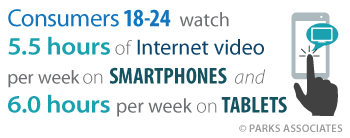
Internet video has evolved. Initially a web-based medium to share individual recorded and animated videos, Internet video has expanded beyond early viral sensations like “Numa Numa” and “The End of the World” to include professionally-produced premium content available through a variety of apps and platforms. Video sharing platforms like YouTube, Dailymotion, Vimeo, and Funny or Die are now household names, even though they have have been part of the Internet video industry landscape since 2005. Additionally, Internet video consumption is no longer limited to websites accessed through a PC browser, as increasing Internet-connected device penetration has encouraged the release of video apps on various mobile devices, streaming media devices, game consoles, and smart TVs.
What constitutes popularity in the online video space has evolved as well. Virality, the ability for a piece of content to achieve widespread recognition in a short period of time, constitutes a large factor in gauging the popularity of individual pieces of content. Virality defies easy classification as no standard definition or metric exists. A general definition, provided by YouTube video creator Kevin Nalty, identifies a viral video as one that receives more than five million views in a 3-7 day period.
Recently, personalities—the on-screen subjects of video content—have become a crucial driving force in generating audiences for Internet video, pushing popularity beyond viral content and building audience recognition and relationships. A breadth of personalities have resonated with Internet video audiences, from well-known celebrities to self-made “YouTube stars” like PewDiePie and Jenna Marbles.
Internet video remains largely short-form in nature, leading to use cases that involve the concept of snacking on video. Short periods of free activity, such as eating breakfast, sitting on a bus, waiting for a doctor’s appointment, or short breaks at work, favor snacking on short-form videos, particularly since they can be location-agnostic as long as an Internet connection is available.
Given the tendency for short-form video to be less of a lean-back experience as is the case with long-form video of 30 minutes or longer, these viewing cases have resonated with Internet savvy Millennials, leading to a tendency for younger consumers to watch the highest amounts of Internet video on smartphones and tablets.
Parks Associates explores the current state of digital video content and future opportunities for content creators and distributors in its Q1 2015 report Webisodes and Multichannel Networks: Future Content Opportunities. For additional digital media research, click here.
The connected entertainment landscape will also be a key topic at CONNECTIONS, taking place May 19-21. For information on speakers and sessions, visit www.connectionsus.com.
Further Reading:
Next: Smart TVs are Dumb, Giraffic AVA is Clever
Previous: Video, Music on Demand are Driving the Connected Consumer Market: Sony’s Philip Jones
















